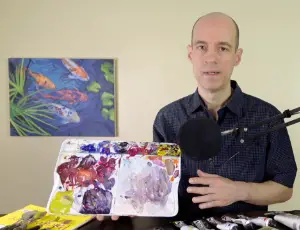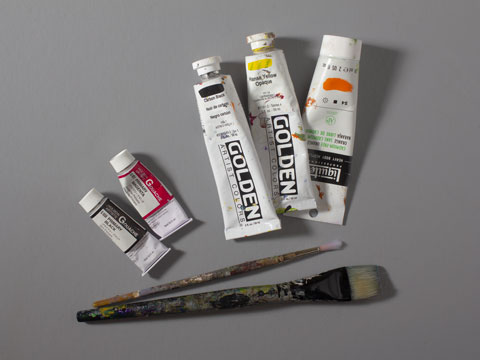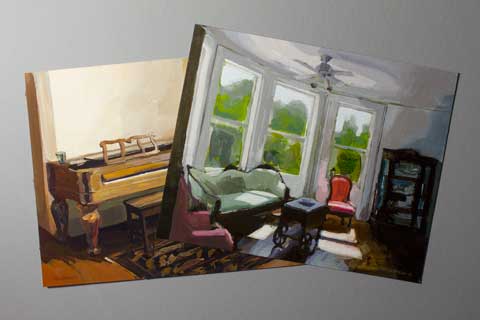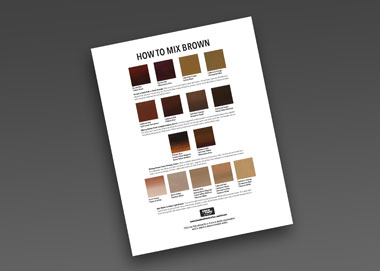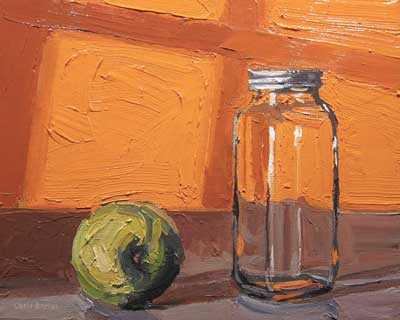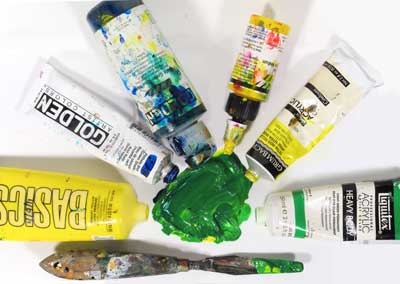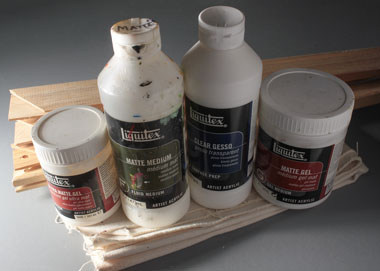If your acrylic paintings contain dull and flat colors, the following tips will help you to create paintings that are bright and vibrant. In fact, I have to restrain myself when it comes to color so I don’t create acrylic paintings that are too garish!
The most important step in achieving vibrant* colors is to start with the most saturated colors that you can find. Avoid the student grade paints and choose a palette of professional quality acrylic paints. Paints made from modern pigments are typically more vibrant than the traditional pigments.
If you have an interest in color like I do, you may want to take a my color mixing course. I use a limited palette of colors, most of which are the vibrant colors that I recommend in this post. Using fewer colors simplifies the amount of choices that you have to make.
In this course I teach the color mixing techniques that I use in my social media color matching videos. It's for beginners and advanced painters. It includes 60 minutes of video.
All links to Blick Art Materials are affiliate links. This means if you click on it and make a purchase, I earn a commission at no cost to you.
Paints that dry to a matte surface appears less vibrant than those with a glossy finish. If you don’t mind the glare, you can experiment with adding gloss medium to your paint. Applying a coat of Liquitex gloss medium as a varnish can also make the color appear brighter and increase contrast.
The design of your painting can also affect the perceived saturation of the colors. For example, strategically placing complementary colors next to each other can make both colors appear brighter. Complementary colors appear opposite of each other on the color wheel**. If the color wheel is not your thing, then think in terms of “warm” and “cool” colors. Another strategy is to incorporate areas of neutral colors to make the saturated colors appear even brighter.
Table of Contents
Avoid Student Grade Acrylics
Many artists who want to try out acrylics often gravitate towards the student grade lines of acrylic paints. I can understand the strategy. They don’t know if acrylic painting is going to work out for them in the long run so they don’t want to spend the money on the more expensive professional artist grade paints.
I’ve had the employees at art supplies stores try to sell me the generic paint by pointing out how much more paint that I can get for the same price. This is a false economy. You may save money at the store but you will waste a lot of time in the studio. Student grade paints often don’t cover as well as professional paints and the colors are usually less intense. It may take two coats to achieve the same opacity as the professional brand of acrylics. You may never achieve the intensity of color you’re looking for with student paints.
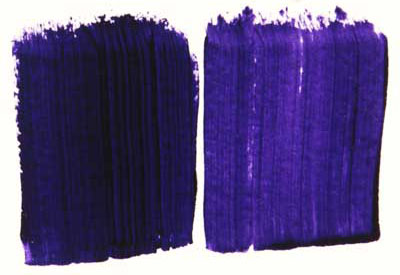
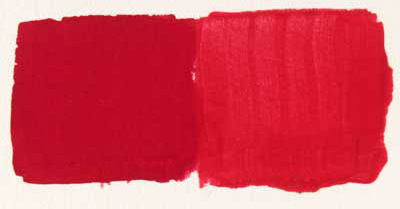
The problem with student paints is that they’re inexpensive for a reason. There are only a few ways manufacturers make acrylic paint less expensive. The first is to extend it with fillers. The most expensive component of paint is the pigment, so they add more of the acrylic binder and other fillers such as matting agents.
Another way to make acrylic paint cheaper is to use less expensive pigments. They usually use a mixture of less expensive pigments to approximate the color that’s listed on the front of the tube. When the name of a color includes the word “Hue” in it, that means it’s a substitute version of the color–it’s not made from the pigment that it’s named after.
For example, Liquitex Basics “Cadmium Red Deep Hue” is made from Naphthol Carbamide and Quinacridone Violet. There’s no Cadmium in it at all! It’s not a scam, it’s just a way to offer a similar color at a lower cost. Sometimes the intention is to make a less toxic version of the same color. This has always been a concern with the line of Cadmium colors because Cadmium is a known toxin.
These “Hue” colors may work for your needs but you’ll often find that they don’t have the characteristics of the original pigment. It may be less saturated, or less transparent than what you were expecting.
Alternatives to Student Grade Paint
If you want to save money, you can buy professional artists grade paints and extend them yourself with acrylic mediums for the areas of your paintings that don’t require intense color. This works well for the underpainting, which is the initial “blocking in” of the major shapes of a painting. Then when you need the very intense colors you can use the paint straight from the tube.
Another option for saving money is to paint in thinner layers. According to The Acrylic Book, which is published by Liquitex, Soft Body acrylics have three times the coverage of Heavy Body acrylics. Three times! Think about that for a minute. If you buy one tube of soft body acrylics, then it will cover the same amount of area as three tubes of heavy body paint! This is one strategy that you implement to reduce your costs while using high quality paints.
You can peruse Liquitex soft body acrylics on blick. They also carry other brands of thinner acrylic paints such as Golden Fluid acrylics.
If you’re concerned about spending money on another line of acrylics, you don’t need to buy more than 3-5 colors, plus white. That’s enough to mix a full range of colors. Many paint manufacturers make small starter kits of their professional colors. Even if money isn’t a concern, a limited palette of colors can save you money and simplify your palette setup.
Modern Pigments Are the Key to Make Your Acrylics More Vibrant
The only way to make your paintings more vibrant is to start with saturated colors. There’s no way to make a painting that’s more saturated than the colors on your palette. Make sure that they’re they’re professional quality acrylics and not the student grade variety as discussed above.
Traditional pigments,*** also known as Inorganic Pigments, are typically made from minerals that are mined from the earth. These are the colors artists have been using throughout history. A few examples of traditional pigments are:
- Burnt Sienna
- Burnt umber
- Red Oxide
- Yellow Oxide
- Cadmium Red Light
Modern pigments, also known as Organic Pigments, are made in a lab using chemistry. They tend to produce brilliant transparent colors. These are some of the most vibrant colors you can find. Below is a list of some of the more popular modern pigments in Liquitex and Golden acrylics. I also included links to each color on Blick.
| Colors | Liquitex | Golden |
|---|---|---|
| Hansa Yellow Medium | [button type=”flat” shape=”rounded” size=”mini” href=”http://shrsl.com/2c8wx” title=“liquitex acrylics”]View[/button] | [button type=”flat” shape=”rounded” size=”mini” href=”http://shrsl.com/2c8vo” title=“golden acrylics”]View[/button] |
| Naphthol Red Medium | [button type=”flat” shape=”rounded” size=”mini” href=”http://shrsl.com/2c8x7″ title=“liquitex acrylics”]View[/button] | [button type=”flat” shape=”rounded” size=”mini” href=”http://shrsl.com/2c8vx” title=“golden acrylics”]View[/button] |
| Phthalo Blue | [button type=”flat” shape=”rounded” size=”mini” href=”http://shrsl.com/2c8xb” title=“liquitex acrylics”]View[/button] | [button type=”flat” shape=”rounded” size=”mini” href=”http://shrsl.com/2c8w4″ title=“golden acrylics”]View[/button] |
| Phthalo Green | [button type=”flat” shape=”rounded” size=”mini” href=”http://shrsl.com/2c8xn” title=“liquitex acrylics”]View[/button] | [button type=”flat” shape=”rounded” size=”mini” href=”http://shrsl.com/2c8wa” title=“golden acrylics”]View[/button] |
| Pyrrole Red | [button type=”flat” shape=”rounded” size=”mini” href=”http://shrsl.com/2c8xt” title=“liquitex acrylics”]View[/button] | [button type=”flat” shape=”rounded” size=”mini” href=”http://shrsl.com/2c8wf” title=“golden acrylics”]View[/button] |
| Quinacridone Magenta | [button type=”flat” shape=”rounded” size=”mini” href=”http://shrsl.com/2c8xw” title=“liquitex acrylics”]View[/button] | [button type=”flat” shape=”rounded” size=”mini” href=”http://shrsl.com/2c8ws” title=“golden acrylics”]View[/button] |
| Dioxazine Purple | [button type=”flat” shape=”rounded” size=”mini” href=”http://shrsl.com/2c8ys” title=“liquitex acrylics”]View[/button] | [button type=”flat” shape=”rounded” size=”mini” href=”http://shrsl.com/2c8yn” title=“golden acrylics”]View[/button] |
| The links to Blick Art Materials are affiliate links which means that if you click on the link and make a purchase, I receive a commission. | ||
Here is a complete list of organic and inorganic pigments from Golden. Some of these paints are a blend of pigments so those have an “X” in both columns.
Most of these colors are highly saturated and transparent, as shown in the photo at the top of this post. The Phthalo blues and greens are especially potent and have a high tinting strength. Tinting strength is a pigments ability to alter a color mixture. Adding a small amount of it to a color mixture will influence it more than you would expect.
A note about tinting strength- some artists ban the use of the Phthalo colors from their palettes because of it’s high tinting strength. It’s so potent it can overpower the entire painting.
Consider adding some of these modern pigments to your palette and experiment with them.
Try Working Transparently
One of the culprits of dull acrylic paintings is relying too much on white to lighten colors. White has a way of dulling colors and making them appear “chalky”. Adding white to lighten a color makes it less intense and it takes on a “pastel” appearance. Pastels are the opposite of high intensity vibrancy, so you need to be conservative with your use of white.
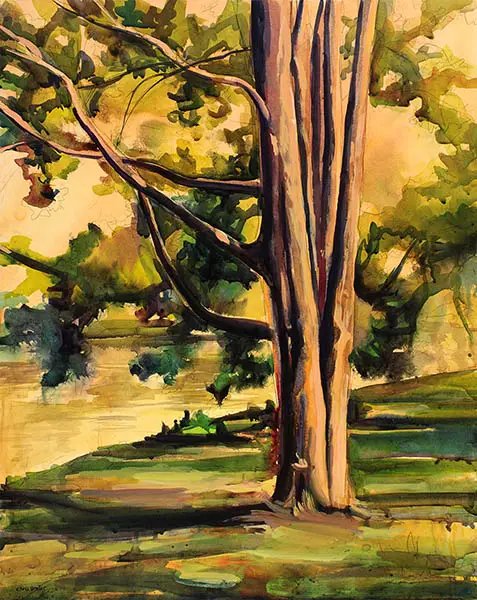
Watercolor paintings often have a vibrancy to them because they’re transparent. When a watercolor painter wants to lighten a color, they’ll add more water to the paint to lighten it. Watercolor painters rarely use white to lighten colors. In fact, many watercolor societies won’t accept your painting into their exhibitions if it contains white.
I don’t necessarily agree with this rule, I’m just pointing out that white lessens the saturation of a color. You can dilute acrylics with water but you don’t want to add too much or you’ll weaken the paint film.
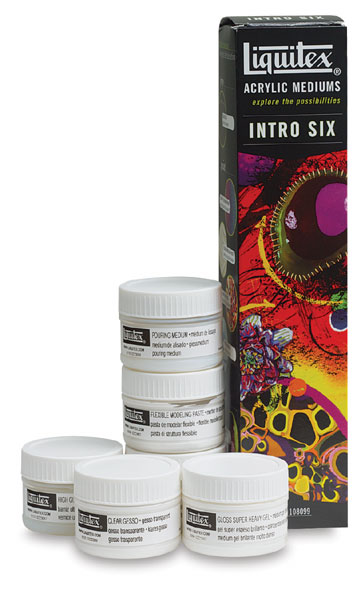
Liquitex Acrylic Mediums
from: Blick Art Materials
Acrylic mediums can be used to lighten acrylics and make them more transparent instead of water. This is called glazing and it can add a lot of depth to your paintings. Liquitex makes glazing medium for this purpose.
There are mediums in a variety of thicknesses, there are super heavy gels and fluid mediums.
Try a few acrylic mediums to see which works best with your style. You can add as much as you want because acrylic mediums are 100% binder.
Knowing When to Use White or Opaque Colors
There’s nothing wrong with using white to mix colors. I wouldn’t ban white entirely from your palette. It’s important to learn when to employ the use of transparent colors to create brilliant colors and when to use opaque colors to cover over previous applications of paint. Adding white to lighten a color is good for painting the brightest highlights. Opaque colors are good for making corrections and sharpening the edges of shapes.
Another option is to use white or other opaque light colors to paint over mistakes, and when it’s dry you can add glazes of transparent colors over the top of it. The fast drying nature of acrylics makes this a breeze compared to oils.
Limit the Use of Black in Your Color Mixes
There are debates about the use of black when mixing colors. I don’t think there’s anything wrong with using black. However, if your colors appear dull and flat, it could be that you’re relying too much on black to darken colors. The alternative to black is to use a complementary color to make a color duller.
It’s possible to use a complementary color to dull the original color down to a neutral gray. The difference is these grays will be more “lively”. One reason is that if both of the complementary colors are transparent, the resulting gray will also be transparent.
Paint on Bright White Surfaces
If you’re going to incorporate transparent colors into your paintings then you should make sure that the support that you’re working on is bright white. Transparent paintings rely on the white surface of the canvas to reflect the light through the transparent layers of paint.
Prime your canvases with a bright white gesso. Don’t tint your gesso with color because that might dull your transparent colors. For example, if you were to tone your canvas with gray gesso, then your transparent colors would appear darker and much less intense.
As you add more paint to your canvas, you’ll eventually be painting over previous layers of color. This can be used to create interesting overlapping effects that would be difficult to achieve by just using opaque colors.
Neutral Grays Can Make Other Colors Appear More Vibrant
Now that you have a few ideas for how to make your acrylic paints more vibrant, it will be easy to overdo it. Resist the temptation to use saturated colors for everything. If every color in your painting is extremely saturated, then nothing will stand out.
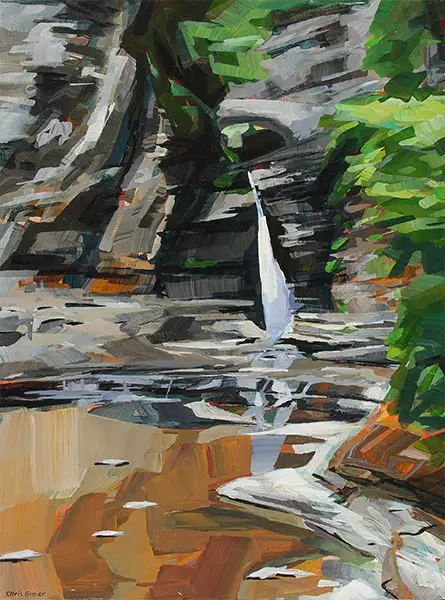
This painting is made up mostly of warm neutral colors, which make the green foliage and the warm bits of orange stand out more.
Instead, I suggest that you employ the use of neutral colors to make the bright areas of the painting stand out. Color is subjective–every color is influenced by the colors that surround it.
You can also use the most vibrant and saturated colors to make the focal point stand out. Imagine a seascape made up of dull silvery neutral blues, and a sailboat with a bright white sail with a few brilliant red stripes. Your eye would be drawn towards the bright white and red sail of the boat.
Use Glossy Acrylics Instead of Matte Acrylics
The surface sheen of the paint also has an affect upon the vibrancy of the color. Matte acrylics dry to a flat dull finish, similar to Gouache. In fact, there’s a brand of acrylics called Acryla Gouache that’s formulated to simulate the appearance of gouache.
Most brands of acrylic have a semi gloss finish when dry. Manufacturer’s try to formulate their paints so they dry to a consistent sheen. The one exception that I’m aware of is Golden Paints. They don’t add any fillers or matting agents to their acrylic paints so some of their colors dry glossier than others. I noticed their Dioxazine Purple dries with more of a matte finish than other paints.
To make your painting more saturated, I would recommend using an acrylic paint with a high degree of gloss. A gloss finish can also increase contrast by making the dark areas of the painting appear darker. For example, a glossy black will appear darker than a matte black. The only downside is the glare can be distracting. As an artist you have to decide which characteristic is most important to you, less glare or more saturation.
As I said at the beginning you can also apply a coat of Liquitex gloss medium & varnish to give the painting a glossy finish.
Conclusion
To make acrylics more vibrant, I would suggest switching to a limited palette of professional acrylics, and be sure to include some of the modern pigments. I’d take the time to learn more about color theory so you don’t have to rely on black to darken colors. These two changes will probably have the biggest impact upon the vibrancy of your paintings.
Learning how to use transparent glazes will add depth and complexity to your colors. The whiteness of the canvas and the glossiness of the paints are something you should consider, but they won’t have as much impact as the other factors.
*Throughout this article I use “vibrancy” and “saturation” interchangeably, they both refer to the intensity of a color. Saturation is actually the correct technical term.
**I avoided the debate about color wheels in this post, perhaps I’ll tackle it in a future post. Color is a complex subject and the color wheel can be useful for beginners.
*** I’m not a chemist so the explanation of traditional and modern pigments is coming from an artists perspective. If you have something to add, then please feel free to leave it in the comments.


